Save Wallum: A radical struggle against destructive 'development' on the suburban fringe (Part 1 - Lessons and insights)

A stereotypical suburban street like so many others…
Relatively modern low-density homes with short-cropped lawns, wide concrete driveways, big newish cars and a juvenile street tree every 20 metres.
But as you round the bend and approach the end of the cul de sac, a distinctly non-suburban phenomenon comes into view.
Just past the last house, the street is blocked off by temporary security fencing signed with ‘no tresspassing, patrol dogs on site.’ To the left, an old caravan painted with a vivid forest mural sits hard up against the fence. Colourful flags on long bamboo poles look like lost folk festival decorations. Artsy hand-painted signage welcoming you to the Save Wallum camp signals that you’re about to enter a different world.
This is an outpost of blockadia – the direct action line in the sand against profit-driven destruction of the global biosphere.
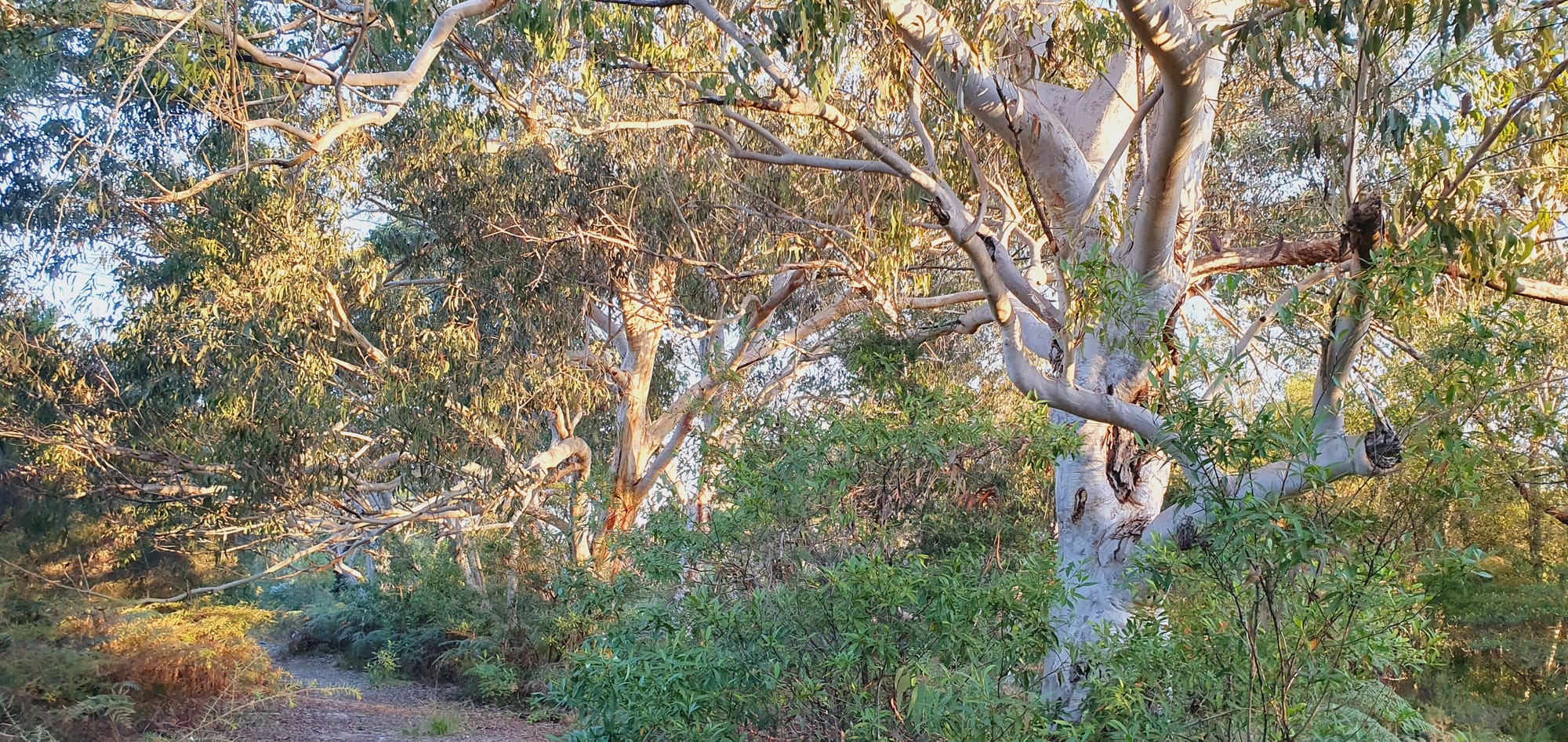
At the edge of this suburban neighbourhood in Brunswick Heads is an increasingly rare patch of Wallum – a coastal heath ecosystem home to several threatened species – which a property developer proposes to carve up and sell.
The heathland is a patchwork of micro-climates ranging from vine forest to sandy ridges to reed-fringed pools where the increasingly vulnerable Wallum sedge frog breeds. Ancient scribbly gums loom over thickets of wildflowers alive with the twittering of small birds and the scurrying of bandicoots and potoroos.

Walk a couple hundred metres down the track and you find the estuarine Simpsons Creek, salty at high tide, fresh at low tide, part of an intact coastal wildlife corridor that runs alongside Tyagarah Nature Reserve to the Brunswick River and out to sea.
This is a special place for both the Arakwal and Minjungbal tribes of the Bundjalung people. Some elders speak of important songlines running through the site.
Clarence Property want to clear and flatten roughly 12 hectares of this fragile ecosystem (which will also cause negative impacts to the wider site by fragmenting habitats and changing how water flows) and subdivide it for 123 low-density residential housing lots, 3 medium-density lots, and a couple of connecting roads.
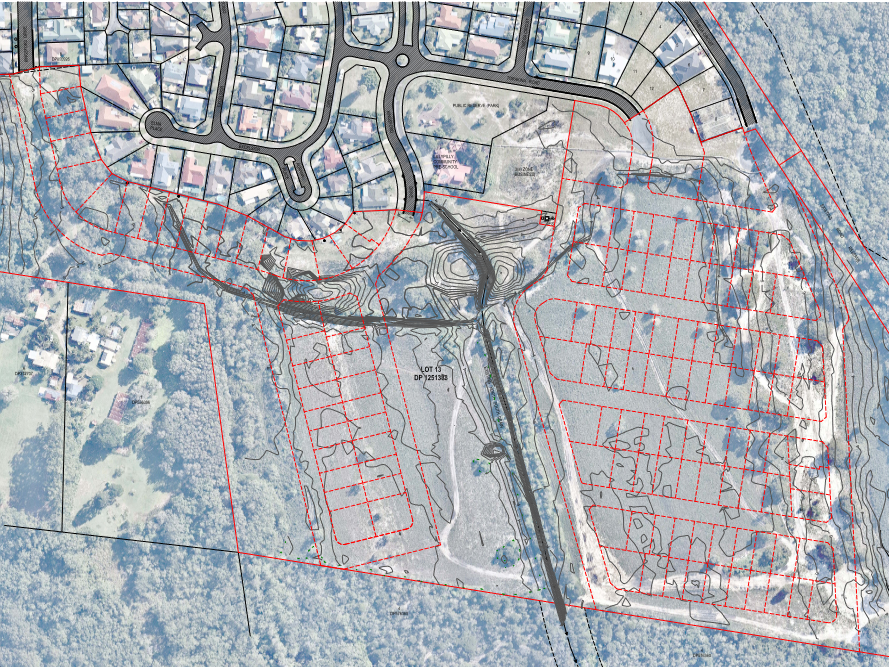
The development approval for this project is a ‘zombie DA.’ Like many other suburban sprawl subdivisions along Australia’s east coast, the original concept plan was approved over a decade ago when environmental protections were slightly laxer. That earlier approval makes it harder for the council to reject the project without having to compensate the developer financially.
The proposed blocks range in size from 450m2 to 965m2. Clarence’s website says prices would start at $750 000 (for ‘vacant’ land), but based on recent sales prices in the region, the largest blocks closest to the creek and remaining forest could end up selling for as high as $1.5 million.
Clarence bought the site for $36.3 million in February 2021. If this subdivision goes ahead, the developer’s sales revenue would comfortably exceed $100 million, without them actually building even a single house.
Under Clarence Property’s plan, they’ll spend a lot of money trucking in tonnes of fill to raise the land, as well as building roads and installing pipes and cables for water, sewerage, electricity and internet. But even allowing for all that, it’s hard to see how their profit margin wouldn’t run into the tens of millions of dollars.
This is not affordable housing. This is ecological vandalism, slicing up stolen Aboriginal land to sell it off for a profit, leaving future residents to deal with the long-term ramifications of building on a floodplain.
If other recent developments are any indication, many of the houses built here would be mcmansions taking up almost the whole block. The properties would be too small to grow much food on, but still so expensive that future residents will have to work long hours paying off mortgages, in many cases commuting 20 or 30 kilometres per day by private car (sometimes much further) to get to work.
This kind of car-centric, low-density dormitory neighbourhood is one of the most expensive, resource-intensive, unsustainable ways humans have ever come up with to house people. Design-wise, it’s similar to many other suburban sprawl developments that are destroying natural ecosystems across the country.
The main difference here is that residents are pushing back.
"You think we'll stop fighting just cos it's been approved? This is the Northern Rivers mate!"
The protest camp grew gradually from February onwards, with residents starting tree-sits after a subdivision works certificate was supported by Byron Shire Council. The vote on this decision split 4 in favour and 4 against (Greens councillors were among those voting against), with Mayor Michael Lyon (a former Green turned independent) using his casting vote to support it, claiming the financial risk of the developers challenging a rejection in court didn’t leave him a choice.
Since then, there have been multiple confrontations where developers tried to bring destruction equipment onto the site, only to be forced back by the community. People have locked onto gates and machinery, standing firm in the face of sustained repression and harassment by police and private security guards.
The largest confrontation was on 17 April. Over 60 cops were called in, including riot police from Newcastle and Sydney – a huge allocation of resources for a town with fewer than 2000 residents – and 19 people were arrested, mostly on charges relating to trespass. But the blockade held firm.
The campaign has already won several impressive victories. Despite the developers gaining all necessary approvals, residents have held the bulldozers at bay for over 5 months. At least one major local contractor has pulled out of the project, and by some estimates, the project delays and intensive round-the-clock security presence may have been costing the developers as much as $100 000 per week.
From late February right through until a recent, successful court injunction in early July, residents have maintained a 24-hour presence blocking at least 4 different site access gates to ensure no bulldozers could enter Wallum. Further volunteers staff a ‘welcome tent’ beside the main road into Brunswick Heads in order to spot approaching police, security and construction vehicles well before they reach the site. People at the Welcome Tent and the different gates maintain contact via walkie-talkies (they have to switch frequencies regularly to avoid spying by the private security contractors), and if a red alert is issued via social media and messaging apps, hundreds of residents can arrive on site in a matter of minutes.
What other organisation can sustain that level of work by volunteers without a single paid staffer involved?
This is now one of the most impactful and long-running community blockades in recent Australian history. One of my reasons for visiting was to understand the ingredients to its success, and see what lessons can be transplanted to other campaigns.
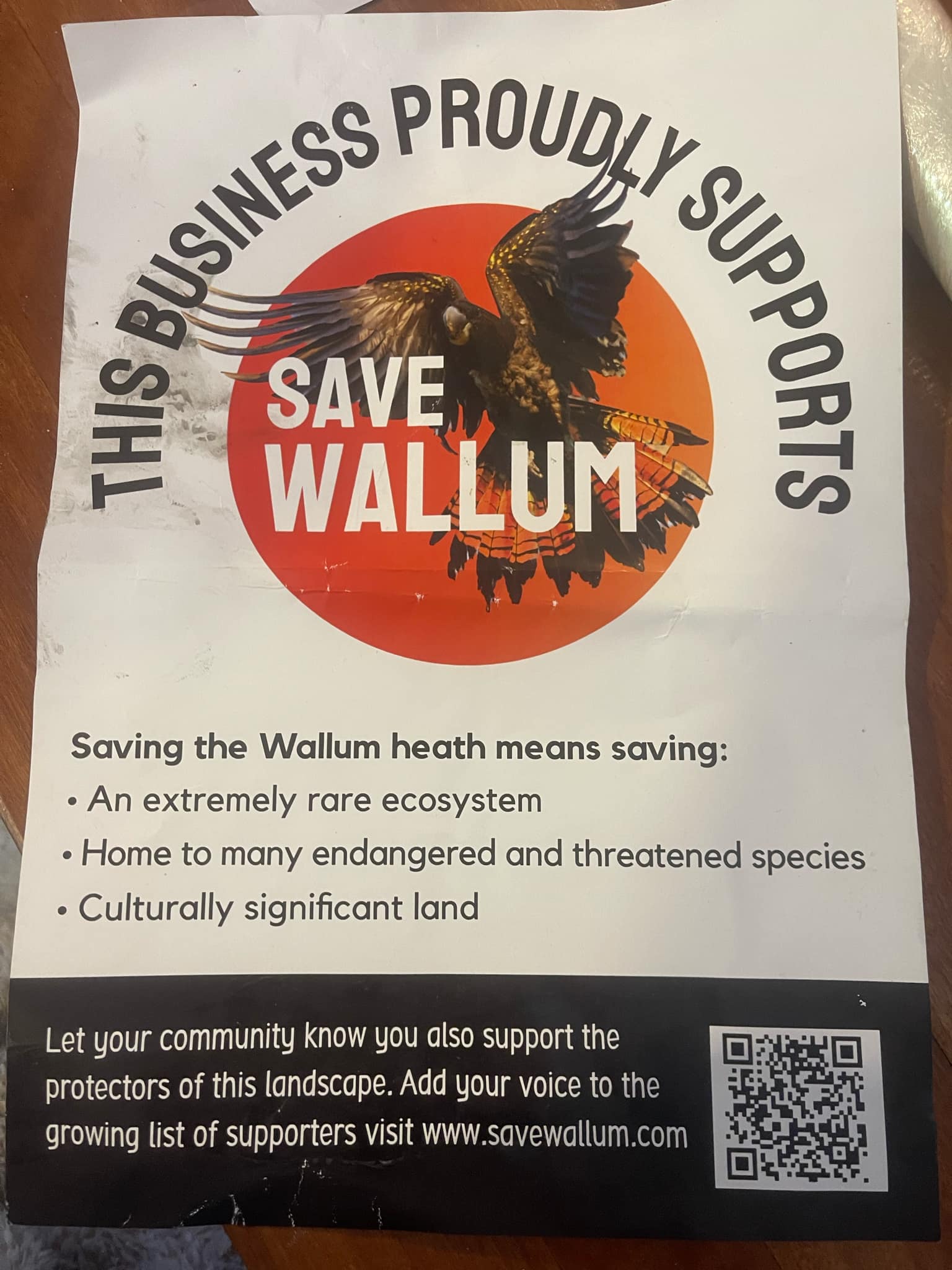
On the frontline
When I arrive at the Brunswick Heads camp, the vibe is pretty relaxed after the court injunction on 4 July stopped work to allow for further legal debates about the site’s ecological significance. Lots of people are taking a few days off from the campaign, and the 24-hour gate roster has been scaled back temporarily.
Blockade camps have a beautiful way of rupturing the norms of colonial capitalism. The space feels like a cross between a large sharehouse and a thriving community centre, with a couple of longer-term tenants sleeping in tents and campervans, guests like me who might stay for a night or three, and many more local residents dropping in throughout the week for either a brief hello or a cuppa and a longer chat.
Most of those on site have taken time off work to be present, and aren’t usually in a hurry to be anywhere else, so there’s more time for free-flowing conversation.
People swim in the creek, enjoy walks in the forest, or jam together by the fire.
Some of the participants spend their time photographing and filming plants and wildlife, documenting Wallum’s ecological values to assist in court advocacy and educating the wider public.
Others diligently tend the sacred fire, which has burnt continuously since Aboriginal elders lit it five months ago.
For many participants, physically connecting with the site on a regular basis helps maintain the energy to fight for it.
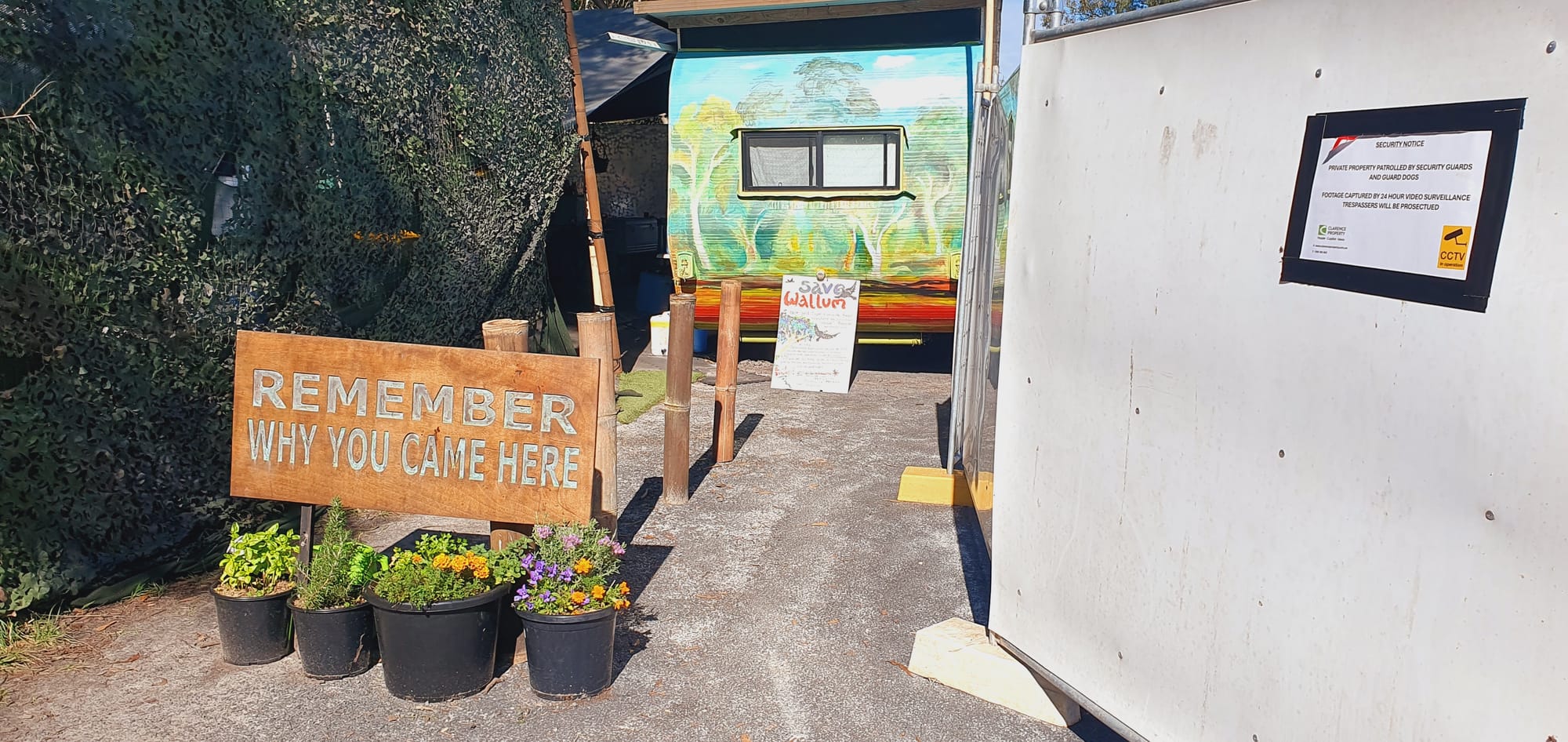
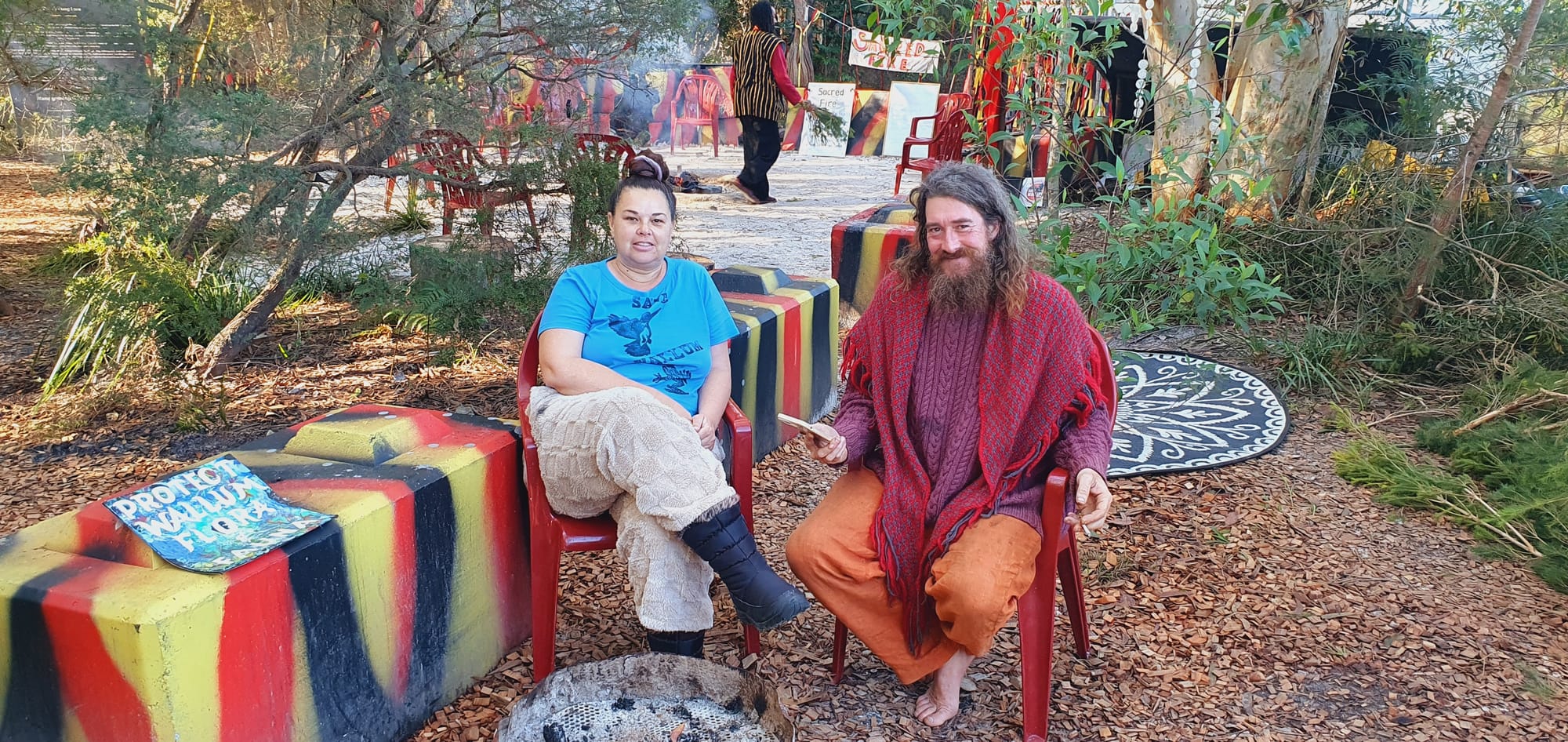
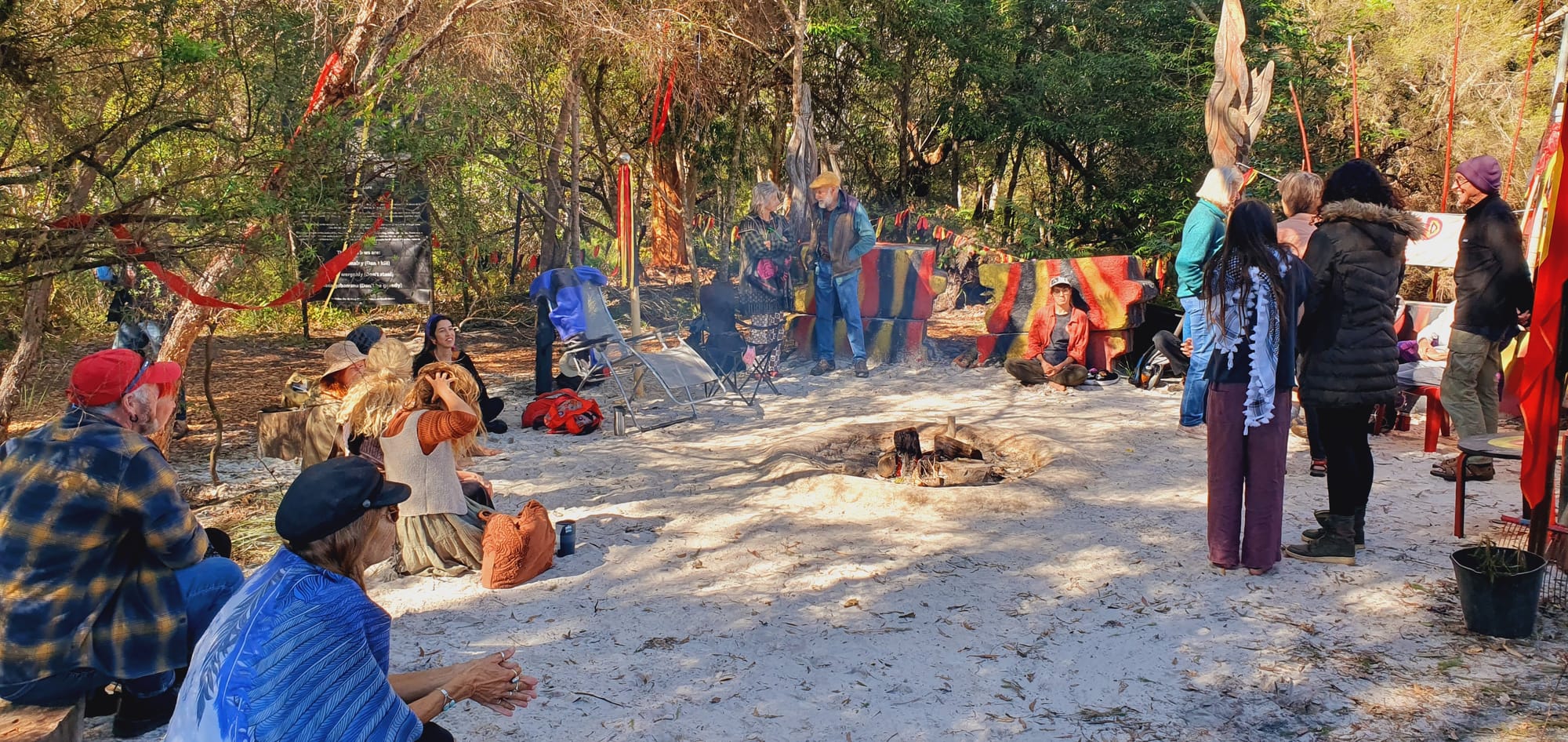
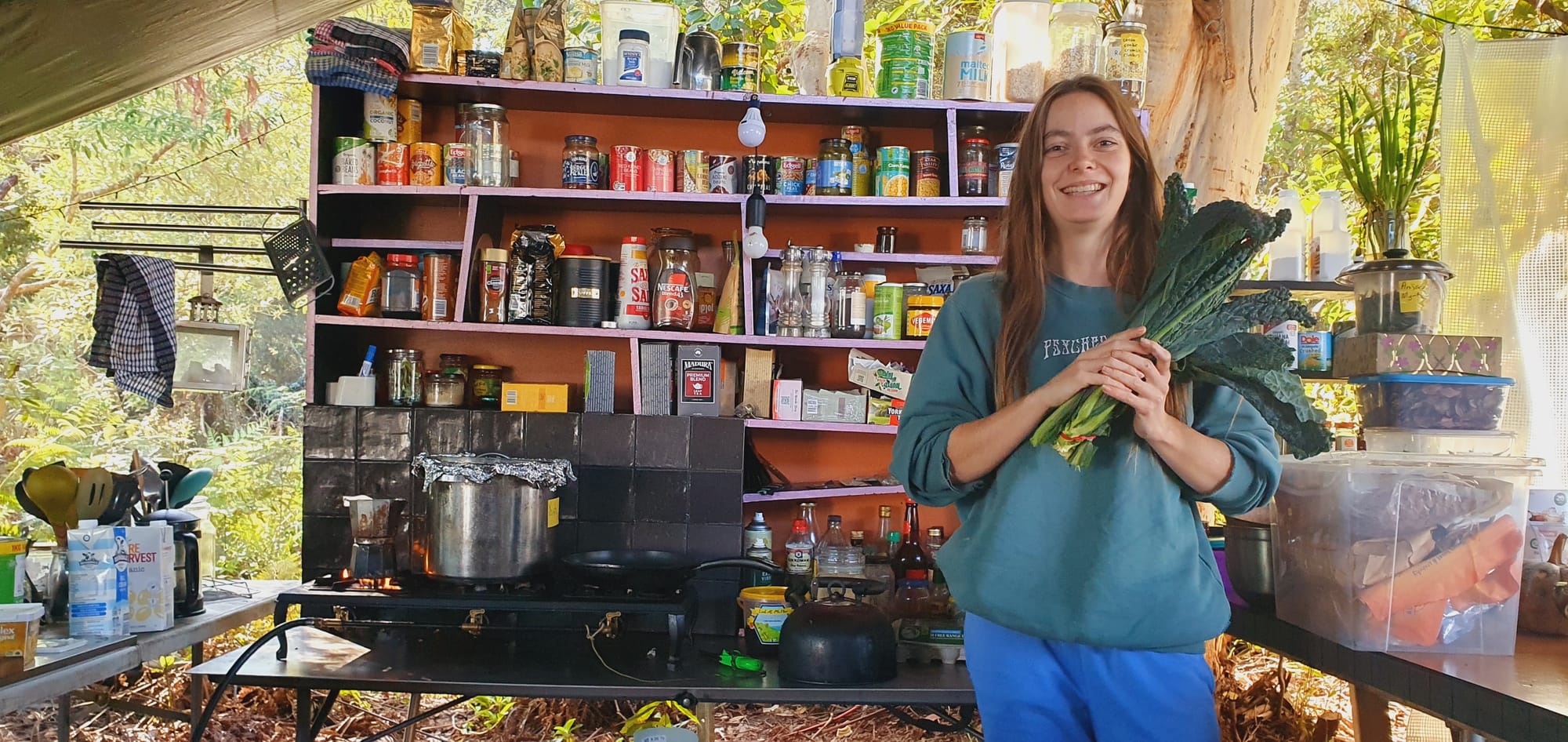
Photos can't quite convey how delightfully weird it is to have a counter-cultural community space like this right on the edge of suburbia
There’s a pretty strong baseline communism at the camp, with everyone contributing what they can. Lots of food has been donated either by individual residents, or by small businesses and local farmers. People cook for each other at the communal kitchen, or share meals dropped off by supportive neighbours.
Discussions at camp fluctuate between the domestic and the revolutionary. One minute it’s “this pot of pumpkin soup has been sitting out all night – do you think it’ll still be ok to reheat?” then in the next breath, we’re earnestly discussing the relative pros and cons of directly locking onto construction machinery.
The level of community support is phenomenal. On top of regular meal drop-offs and shopping runs, residents who live nearby take turns washing tea towels, bedding and clothes for the long-termers, delivering jerry cans of filtered drinking water (some of the Northern Rivers crew seem much fussier about drinking tap water than the average Brisbanite), and even helping with stuff like portaloo cleaning and maintenance.
This is prefigurative anti-capitalist praxis. For a network of volunteers to sustain this level of work for such a long time is a powerful reminder that societies can indeed function successfully without everyone being motivated solely by greed and personal profit.
Spontaneous afternoon jam by the fire - hang around with a guitar for long enough and eventually some blow-in from Brissie will whip out his clarinet
What should we be learning from this?
Unlike most blockades, Save Wallum has the obvious advantage of being right next to a supportive residential suburb. This brings a few challenges in terms of not generating too much late night noise that might wear down neighbours’ patience. But it also means hundreds of people living within walking distance who can rock up at short notice if a red alert is called, and much more logistical support to sustain the onsite presence.
This is undoubtedly one of the key ingredients behind its success. It’s so much easier to sustain a blockade that’s easy to get to. Local residents can sign up for a late-night shift on one of the gates and still head home to a comfy bed and a hot shower (the same was true of Brisbane's refugee detention centre blockade in Kangaroo Point in 2020).
The camp has become a neighbourhood meeting space and social connection point that people drop into just because it’s a fun place to be.
But it wasn’t necessarily a given that so many residents and local businesses would get behind a campaign like this. The proximity of so many residential homes could’ve been a hindrance rather than an asset if not for the campaign successfully building so much community support early on.
Between Australia’s broader housing speculation crisis, the covid-related supercharging of the Byron housing market, and the 2022 floods that abruptly reduced local housing supply and permanently displaced hundreds of Northern Rivers residents, mobilising opposition to a relatively small residential subdivision could’ve proved challenging. Across Australia, there are plenty of voices arguing that now is not the time to be blocking new housing developments.
But even residents living down the road in the pods (compact, relocatable, temporary housing for flood-displaced locals) are opposed to Clarence Property’s Wallum proposal.
This is because even before the final approvals came through, key instigators did a fantastic job of raising consciousness and educating the public about the site’s environmental values.
Brunswick Heads is in Byron Shire, where the Greens regularly get close to 50% of the primary vote. But organisers didn’t take it for granted that everyone would actively support a civil disobedience campaign to protect a natural green space that most locals didn’t know much about.
Using a range of socials channels (including the Save Wallum – Brunswick Heads Facebook group, which now boasts 7600 members), local environmentalists shared posts and videos highlighting different aspects of the Wallum ecosystem, while wildlife photographers and videographers captured and distributed top-quality images of the plants and animals.
At a time when it’s getting harder for non-profit causes to reach people on social media organically, Save Wallum managed to cut through, with dozens and eventually hundreds of people sharing their own images and experiences of the site.

I don’t want to oversell the importance of social media – numerous other factors have contributed to how successfully the campaign has grown. But during my time at the camp I was repeatedly struck by the fact that so many people had developed both a deep emotional connection to the site, and a strong scientific understanding of what made it special. Multiple blockaders told me how early engagement through social media helped build that knowledge, which in turn increased people’s motivation to rock up on site.
The level of ecological education that a bunch of volunteers have pulled off here puts most government-run public information campaigns to shame. Alongside the strong online footprint, the campaign has organised a range of educational and training events that brought people onto the site to connect with it directly. Organisers tell me that some weekends there were literally hundreds of people turning up for guided walks led by local ecologists and bush regeneration experts.
The guided ecology walks often took place immediately before or after training workshops on non-violent direct action. So in one afternoon, people could come to learn about how special the site was, then learn how to protect it.
The campaign has become a many-headed hydra. On the Friday night, I carpool down to Byron Bay's Arts and Industry Estate (16km from Brunswick Heads) to help set up for an art fundraiser where dozens of artists have donated work to help fund the campaign. The event is packed with people of all ages, and smashes its fundraising target.
There was a solid turnout for the Friday night art exhibition fundraiser in Byron Bay
One week later there’s another cultural event onsite at Bruns – an exhibition of artworks by primary school-aged kids. The temporary security fencing has been reclaimed as a gallery wall; drawings of potaroos and glossy black cockatoos are stuck up along the white barricade.
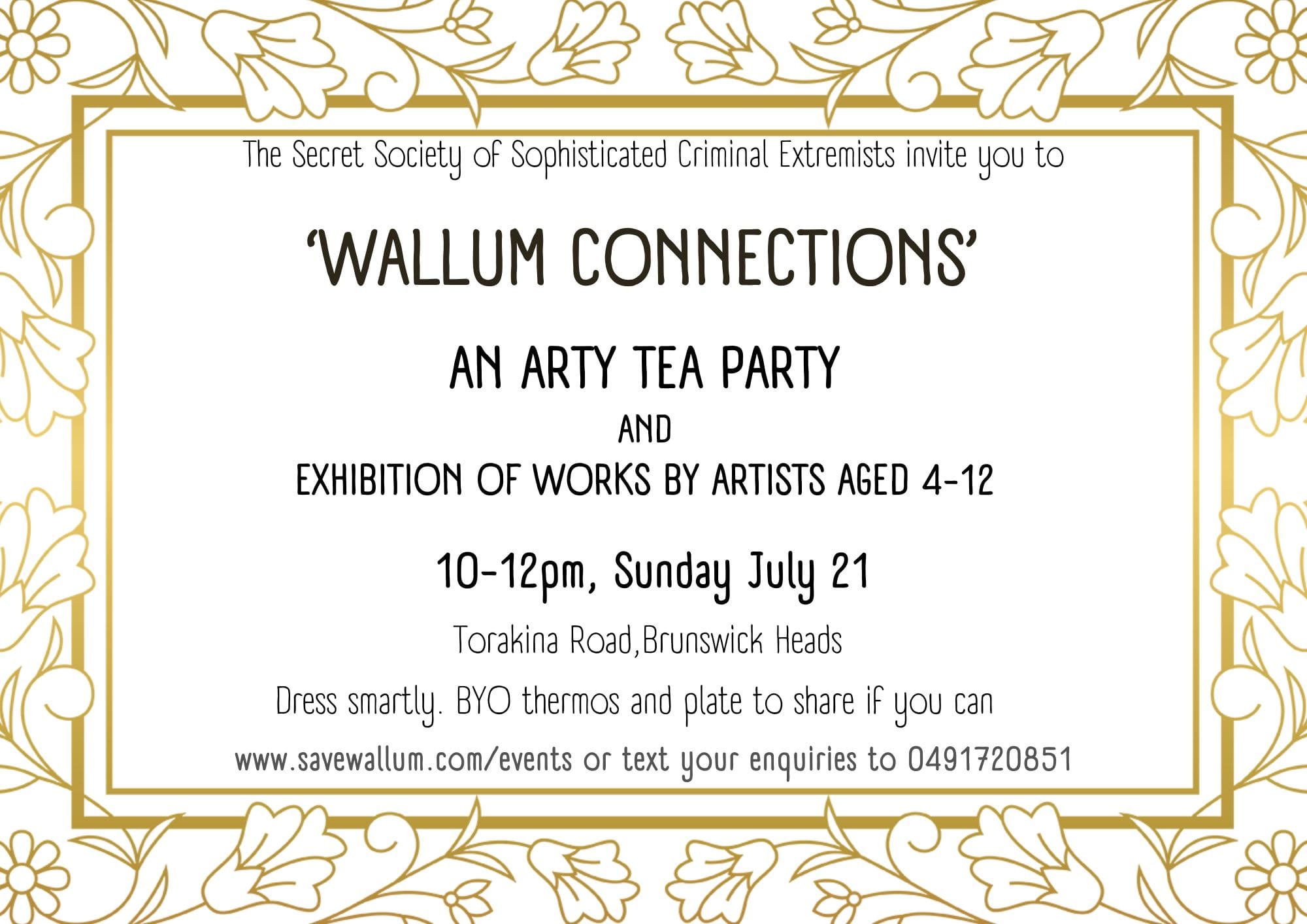
Meanwhile another crew of volunteers staff a stall every Friday at the Mullumbimby Farmers Markets selling merch, collecting signatures and keeping the wider community informed about how the campaign is going. Save Wallum certainly isn't restricted to Brunswick Heads locals – the whole region is getting active. Several long-termers at camp have even driven down from the Gold Coast and further afield to take part.
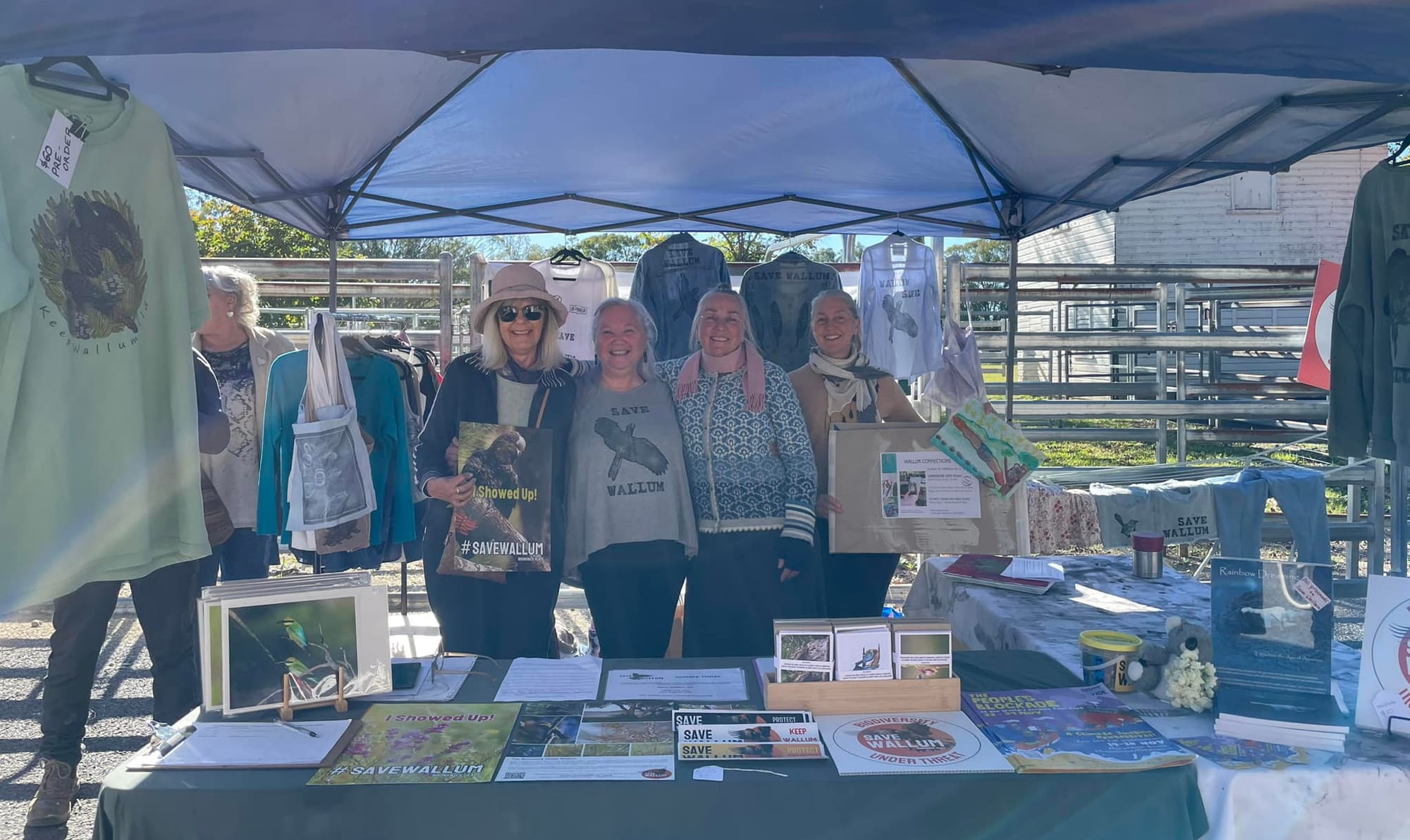
While I can’t possibly describe and dissect every element of a campaign of this size and diversity, it’s worth mentioning that Save Wallum’s general cultural resistance to rigid hierarchy or pedestalling charismatic individuals is serving it well. Following in the tradition of the 2014 Bentley Blockade, the movement seems to welcome and tolerate a broad diversity of tactics, and there’s no dogmatic insistence about ‘staying on message.’ It was heartening, for example, to see broader messaging about Aboriginal land rights and freeing Palestine included at the Friday night community fundraiser.
Rather than insisting that everything has to be exclusively about Wallum, organisers have allowed the blockade and associated online spaces to also be used for other connected struggles and community events. The day after the art fundraiser, a deep ecology workshop draws about 30 participants to the site. Crews like the Rising Tide convoy from Newcastle have also passed through camp, organising info sessions about climate activism and forging local connections.
The fact that the campaign's largest online channel for distributing info is a public Facebook group (rather than a page), and that offline personal networks around Brunswick Heads are so strong, also helps democratise communication, preventing too much power concentrating in the hands of whoever controls the socials accounts and mailing lists.
Decentralisation has also helped insulate against repression and burnout. In some cases, police have tried to cut out perceived leaders by imposing onerous bail conditions that prevented them returning to camp until their court dates. But by sharing knowledge about internal systems widely, and training so many people in the different skills required to sustain the blockade, the campaign has ensured it can continue even if one or two key people get sick, busy, or dragged off in a police van.
If the government did want to target campaign leaders more aggressively, it would have a hard time identifying who they are. So many people have taken on leadership responsibilities of one kind or another, and new faces are continually stepping up.
For campaigns like this to take off, you need enough people with the right combination of cynicism towards government, and faith in the potential of collective action to create positive change. There are plenty of towns around Australia full of residents who don’t trust politicians and property developers, but usually they are equally skeptical about the chances of protest actually working.
Byron Shire has the necessary critical mass of residents with anti-establishment tendencies but who still feel optimistic that the mainstream system will be forced to respond if they can apply enough pressure.
Competing visions of change and protest
In every community, you can find a spectrum of attitudes towards protest, and what specific kinds of direct action are considered worthwhile and ethically justifiable.
It’s fair to say that in the Northern Rivers, baseline support for activism is much higher than most parts of the country, reflected in and reinforced by a long history of successful community campaigning against deforestation and coal seam gas in particular. However there’s still a large chunk of the population who are inclined away from more antagonistic forms of protest. Byron Shire’s particular brand of conflict-avoidant counter-culture is often instinctively resistant to tactics and rhetoric that might be seen as confrontational, divisive or polarising. Perhaps this reflects the fact that many of its residents chose to move here rather than fighting to change the cities and towns they came from?
But Save Wallum is teaching a new generation of locals that disruptive protest is not only possible but effective, normalising lock-ons, tree-sits and defying police directions as reasonable steps for ordinary people to take when governments ignore their wishes. It comes at an important time in the shire’s evolution – it’s both a test case for whether protest and resistance will be watered down as prices rise, and an opportunity to radicalise newer residents.
So many of the participants I've met here – including those taking ‘illegal’ actions – have been first-timers. I feel like this campaign is going to leave a timely cultural footprint on the Northern Rivers that helps counter-balance the don’t-make-waves apathy of all the big money moving into Byron Bay and surrounding beaches.
The entire Byron Shire, from South Golden right down to Bangalow and Suffolk Park, has a population of barely 37 000 residents – pretty small in the grand scheme of things (in contrast, just the Gabba Ward of Brisbane City Council, which I used to represent, is home to over 57 000). But if a few thousand east coast residents are learning non-violent direct action skills to resist unsustainable development, and thousands more are waking up to the fact that civil disobedience is a necessary, indispensable tool in the social change toolkit, the ripples of radical change could be significant not just for Byron, but the broader SEQ/Northern Rivers region.
Talking to people involved, you get the sense that for most of them, this campaign is about much more than just saving Wallum – it’s about uniting to push back against unjust, unsustainable systems of all kinds. There's a growing understanding that blockade tactics need not be limited to far-flung forests or mine sites. And the skills people are learning here will be highly transferrable to other struggles.
Some blockaders are already talking about relocating and establishing a new protest camp at another development site in the region once they win here at Wallum. It feels like the property industry is about to get a long-overdue kick up the bum.
How this campaign ends, and what comes next, is still up in the air. But it would be a mistake to overlook or underestimate its latent potential...

In Part 2, I explore the broader political significance of Save Wallum, and where it fits in the wider landscape of struggles against unsustainable residential development (subscribe to my email newsletter so you don't miss it).
If you value writing like this, and would like to support me to produce more political commentary and analysis, please consider signing up for a paid subscription.
Note: This piece was informed by dozens of conversations I’ve had while camping out at the Save Wallum blockade in Brunswick Heads. I’ve avoided photographing and directly quoting most of the people I’ve spoken to, because in an era of increasing state surveillance and repression of peaceful protesters, documenting individuals’ involvement in direct action potentially increases their exposure to targeting by law enforcement. I feel very grateful to everyone who has shared their thoughts with me, and incredibly inspired by the selflessness of all the activists who are contributing to the ongoing campaign.
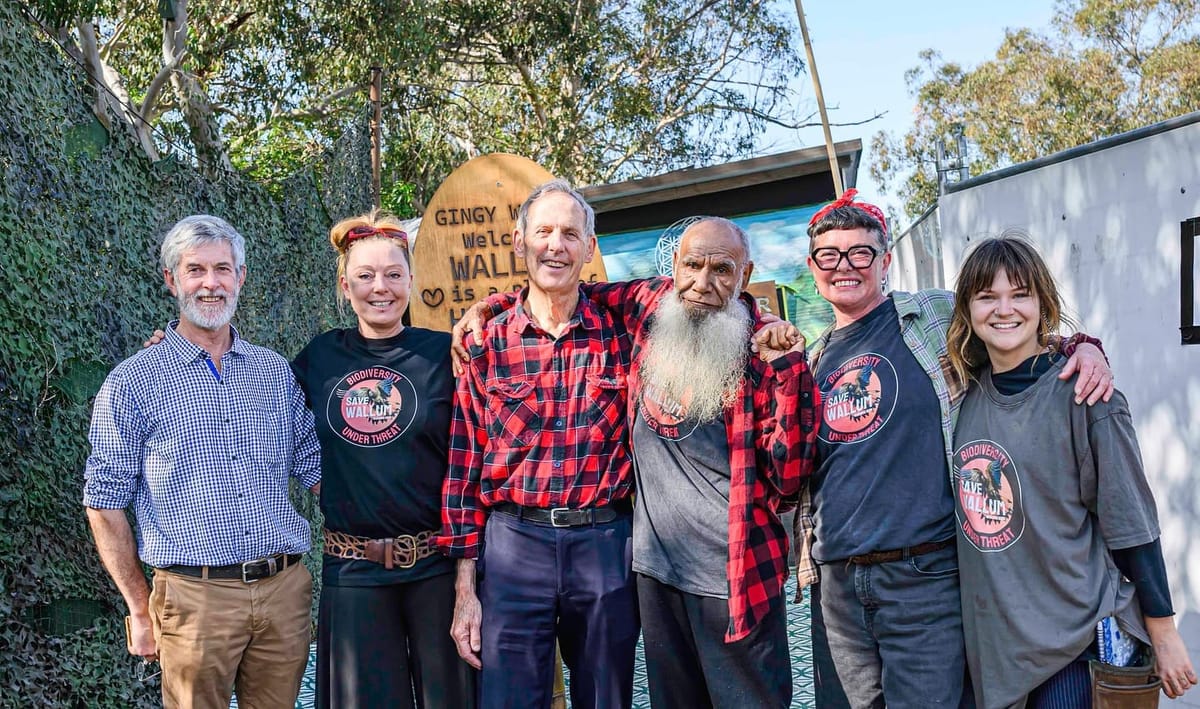






Member discussion